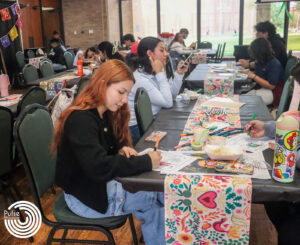Student Filmmakers Represent at STXIFF
From a lonely San Benito gas station, to McAllen’s Escandon Skate Park, to the Santa Ana Wildlife Refuge, UTRGV students are mapping out life in the Rio Grande Valley in the short films that were featured at the 2023 South Texas International Film Festival. All of the short films were made as class projects and found a life of their own in the film festival circuit, starting in Edinburg.
At the Sept. 14, 2023, student short film screening, the crowd poured into the old Edinburg Auditorium. All three student-made short films were received with raucous applause, cheers and whistles from the audience. Audience members were moved to tears or screaming with laughter. Each short film achieved its intended effect and the student filmmakers, Armando Ramirez Cardenas, Jared Palomares, Andrew Perez and Angie Rocha felt every minute of it.
One of the first short films to be screened was “3:00 am The Graveyard Shift,” written, directed and produced by Ramirez Cardenas, with music by Joseph “Jrokk” Schaetz, Juan Pablo Gracia Barajas, Arturo “Morfo” Peña, Jesse “DEM” Garcia, Facundo Gomez Bruera and Carlos Lojero.
The “3:00 am The Graveyard Shift” short film follows a cashier through his night shift at a lonely gas station. The music pierces through the monotony of the beeping scanner, the cash tray popping open and the door’s bell ringing as people filter in and out of the store. The short film is in black and white with surveillance-like footage and the audience becomes a true spectator, watching people pass through.
Ramirez Cardenas, who was nominated for the South Texas Director Award (Rio Grande Valley category), said he wanted to represent a different side of the RGV.
“I was a cashier, and I was like, ‘I’m seeing this little world right here,’” he said. “It’s a small town, San Benito, not even the city of San Benito, but way out, the outside of San Benito, closer to the border fence. So there’s border patrol, sheriffs, state troopers, people from Mexico, people from the U.S., so I was like, ‘Oh, this is the RGV.’”
Ramirez Cardenas started as an accounting student at Stephen F. Austin State University, but after taking a five-year hiatus to travel across Texas, see different things and meet different people, he set his mind on finishing his degree. His short film was made with the intention of providing a connection between the art world and the people who may be outside the art world, the people who frequent the gas station after hours to buy Natural Lite, cigarettes or candy.
“[I’m] just trying to reach out to people, as well, that might not understand art,” Ramirez Cardenas said. “They’re like, ‘Hmm, art.’ They’re like, ‘Well, I don’t know. I don’t have time to go to a museum or to a concert or to watch a movie or I don’t understand it,’ and they feel intimidated to not go. But this one, I wanted [them to be] like, ‘Oh, I relate to that.’ And a lot of people did.”
After recording every five-hour shift for over four weeks, he broke down over 20 hours of footage into 20 minutes. Ramirez Cardenas edited day and night for almost three months to carve out the pacing of the short film. He wanted it to feel like an actual graveyard shift, the rushes, the lulls, the random musings that come to mind when it is just you and a hungry dog, alone, in an empty parking lot.
“Everything just fell into place so beautifully,” he said. “Like, I don’t know, I just knew I had something. Like, the Valley is magical here. So, I really didn’t have to do much. It was just here waiting to tell itself really.”
Ramirez Cardenas got his start with a fifth grade Mother’s Day essay competition. He said he saw a side to a mother’s life that many other students did not see. He saw his mother go to work all day just to come home and work some more for a household that was not as grateful as they could have been. The judges saw something in his unique perspective and he won the competition.
“I feel like I’ve always had an eye,” he said. “Like, I’m very quiet and maybe people are afraid of that. Like, ‘Oh, this guy, he’s so serious.’ I’m just trying to look. Like in the museums, right, you look at a painting. And so, I’m walking around and I’m looking at things, trying to notice things and then I try to put that on screen or in drawings. And if it comes out the way that I thought in my head and people see that and are like, ‘Oh yeah, yeah, yeah’, I’m like, ‘OK good. I’m on the right track.’”
“Hit Astray,” tells the story of a group of friends, two who are secretly in love with each other and a devastating event turns everything upside down. Written by Palomares and edited by Perez, both directed a group of classmates and friends in a short film that was a crowd favorite at STXIFF and was nominated for the RGV Short Film Award.
“I wrote up a coming of age [story],” Palomares said. “Two best friends that are aching to be with each other. … It’s 2008, it’s a weird time and the Marriage Equality Act wasn’t set in stone yet, it was still coming. … These are teenagers or young adults, however you interpret it. And something happens to them that changes their lives and that essence of the story seems very poetic and beautiful because there’s so many ways you can interpret what that means for today because it’s a timeless story. So, that’s what inspired us.”
“Hit Astray,” with its pro-style lighting and camera work, becomes a visual experience and an emotional journey. Palomares knew that as soon as they started filming they had something special.
“When we first started filming, I saw the first shot … I felt emotional,” he said. “I was like, ‘This is possible with what we have. It’s not the impossible.’ You can make something beautiful with what you have.”
Palomares and Perez saw their worlds shift when the pandemic happened in 2020. Palomares had plans that were quickly derailed, and it seemed like the world was falling apart.
“The pandemic happened, and I thought, ‘I’m not sure what I could do,’” he said. “I didn’t know I was going to go to college. I thought everything was gonna be shut down and we were going to live in a very different world than we are right now. … I saw a little light at the end of the tunnel. I saw that there’s hope and I said, ‘Well, I mean if this is how the world is now, then maybe I should just do what I love,’” Palomares said.
Perez, who was nominated for the South Texas Cinematography award, always had some kind of camera in his hand. Documenting life has always been a part of him and in 2020, he took a chance on his passion and started his career in film. He said that filming “Hit Astray” was a rewarding process, and even though he had a few film projects under his belt, making this short film was still a learning process.
“Everything I do is always a learning process but Jared, even though this was technically his first film, he just crushed it,” Perez said. “He really knew what he wanted from the actors and what we wanted from the actors and how to basically turn the script into a real thing. Everyone felt very connected, really, from the start and I think that was very helpful to be able to finish this in three days, literally. We shot this in three days and as Jared had previously mentioned, the stars aligned in those three days. Everything just came perfectly and we are very thankful that that happened.”
Palomares, who won a $250 UTRGV Scholarship in honor of Dr. Marian Monta, said the film has a universal theme and hopes the audience walks away with that message.
“It’s important,” he said. “I think the theme of the film is loving who you want to love, no matter the boundaries, before it’s too late. Before you lose that chance of telling that person what you feel about them. Love has no boundaries and no matter the time, era, we should be true to ourselves and experience those feelings and connect.”
Angie Rocha, environmental science major, directed, produced and wrote a short film that centers on the interconnectivity between people and the environment, as well as the fundamental sense of belonging that she finds in nature. The film was produced as an “About Me” class project. “Soy Todo, Soy Nada,” follows Rocha as she makes her way through Santa Ana Wildlife Refuge on a bright, hot day. The audience hears her voice bleed through the sounds of the birds and insects all around her and her words lead them on a meditative journey of self-discovery.
What started as a poem became a narrative short film that captures the beauty and the mystique of nature and self-actualization in the RGV.
“From my own experiences, growing up, I lived in a colonia–low income–and we didn’t have a lot of toys to play around with, so the only thing left was nature–climb trees, play with the mud, play with dogs,” Rocha said. “Also we didn’t have cable. So, all I would watch is, like, animal documentaries in Spanish. That’s all I ever knew, interacting with the Earth.”
Now a farmer, Rocha said her knowledge feels innate. Her knowledge of the land has been passed down through generations in her family. Her connection to the land has come from her family history, as her grandparents were farmers and her father picked the harvest.
“Learning the term for what I believe in is, like, animism,” Rocha said. “So, it was kind of connecting, piecing it all together like, ‘Oh, me, the land, the ancestors, the spirit, they’re all connected.’ And how do I make this message known, at least for me, to express it in some way and for others to resonate because I didn’t know that there was other people who thought like me. I at least need to make a film that honors, you know, everyone in my lineage and honors the Earth and makes those connections.”
She said her mother, grandmother and the nature of their teachings motivated her to write the script in Spanish, their native language. Writing the poem that became her script led her on a journey of self-discovery and a realization of what interconnectivity means.
“Realizing there’s so much that actually ties us, and so many experiences, just being women and of the same lineage, and it made me love them even deeper,” Rocha said. “I already loved them but then now I see it like a string attached to every single one of them and all of us and it’s just like an appreciation, even more deeply of community and of being woman and of being of the same lineage. So a lot of self-discovery through others and through me. A lot of two-way connections. I was really happy writing that.”
Rocha said all are born from the Earth and in that realization, there is a sense of commitment, responsibility and love that one should have for the land, just as one has for their family and their community.
“I think a lot of people could understand the part of coming from ancestry … but I want them to get a fuller sense of community–redefine what community means to them so not only people but animals, plants, dirt, water, air, fire,” Rocha said. “So, I want them to push those boundaries and be like, ‘We are all connected.’ … I want them to realize that in a certain sense we are all birthed from the Earth. Normalize not only being in love with those around you but normalize being in love with the environment.”
Rocha also received the $250 UTRGV Scholarship in memory of Dr. Marian Monta. She said STXIFF provided local filmmakers with the opportunity to get to know one another and build community ties.
“It’s kind of a connection and a sense of belonging, too,” she said. “It’s like, ‘Oh, I’m so glad that there are people here in the community that are already making films that are making these spaces available not only for themselves but for future generations.’ And so, it was really nice connecting. I think that was my major takeaway from it. I connected not only with my family through my film but with other locals and just knowing other artists and their feelings.”








